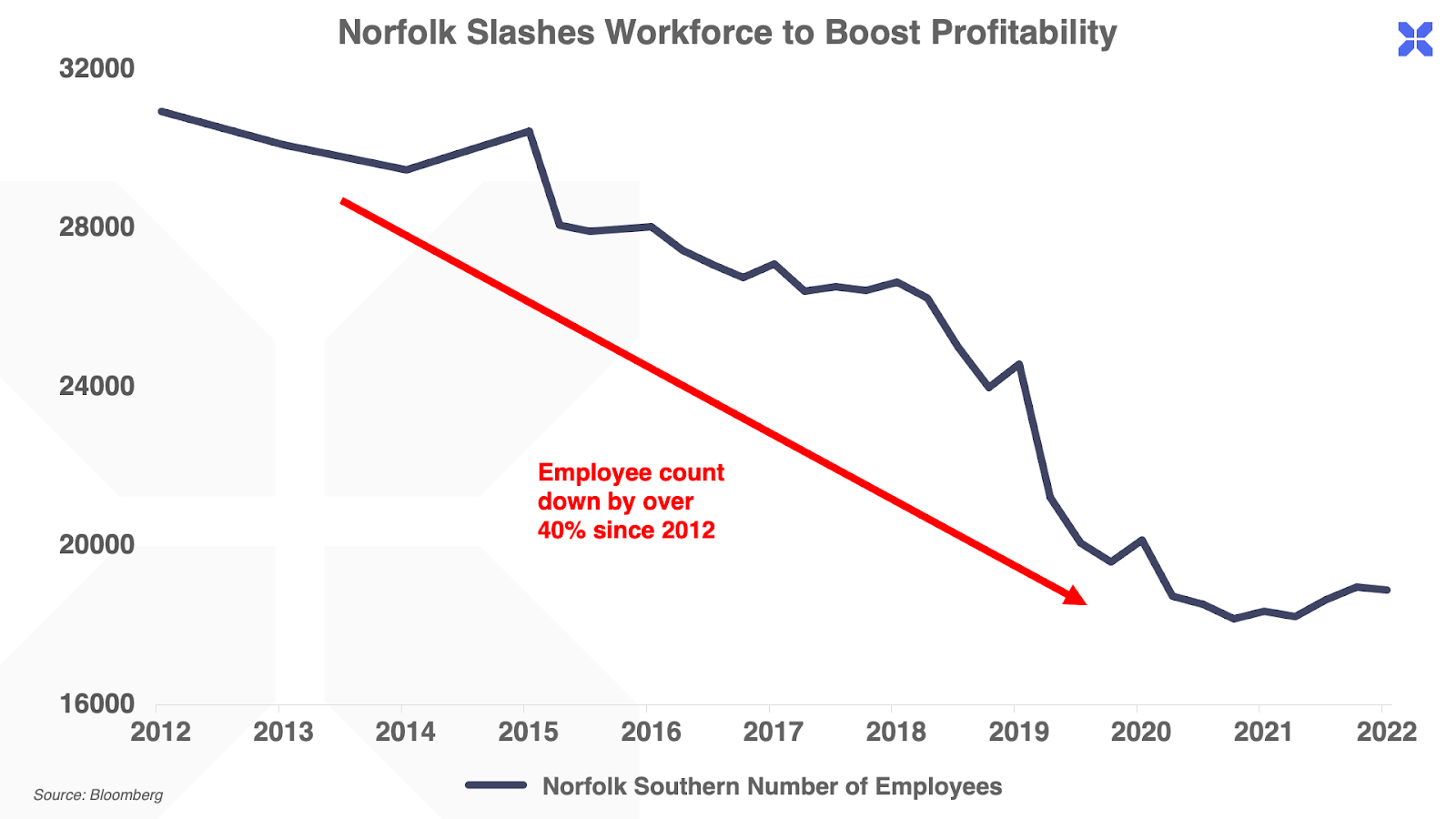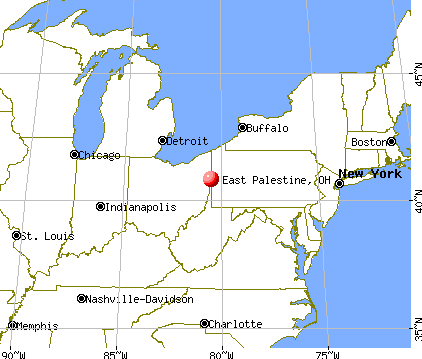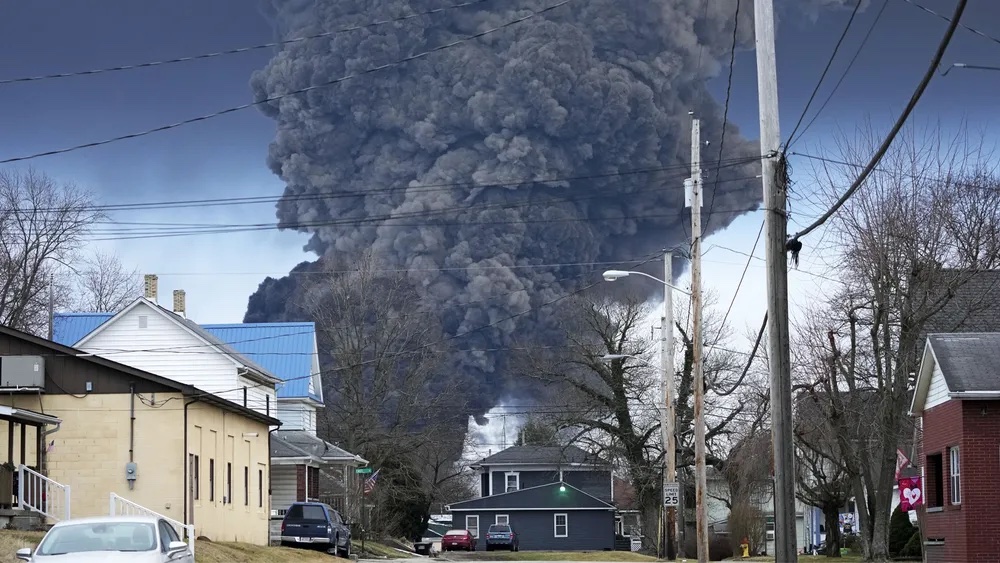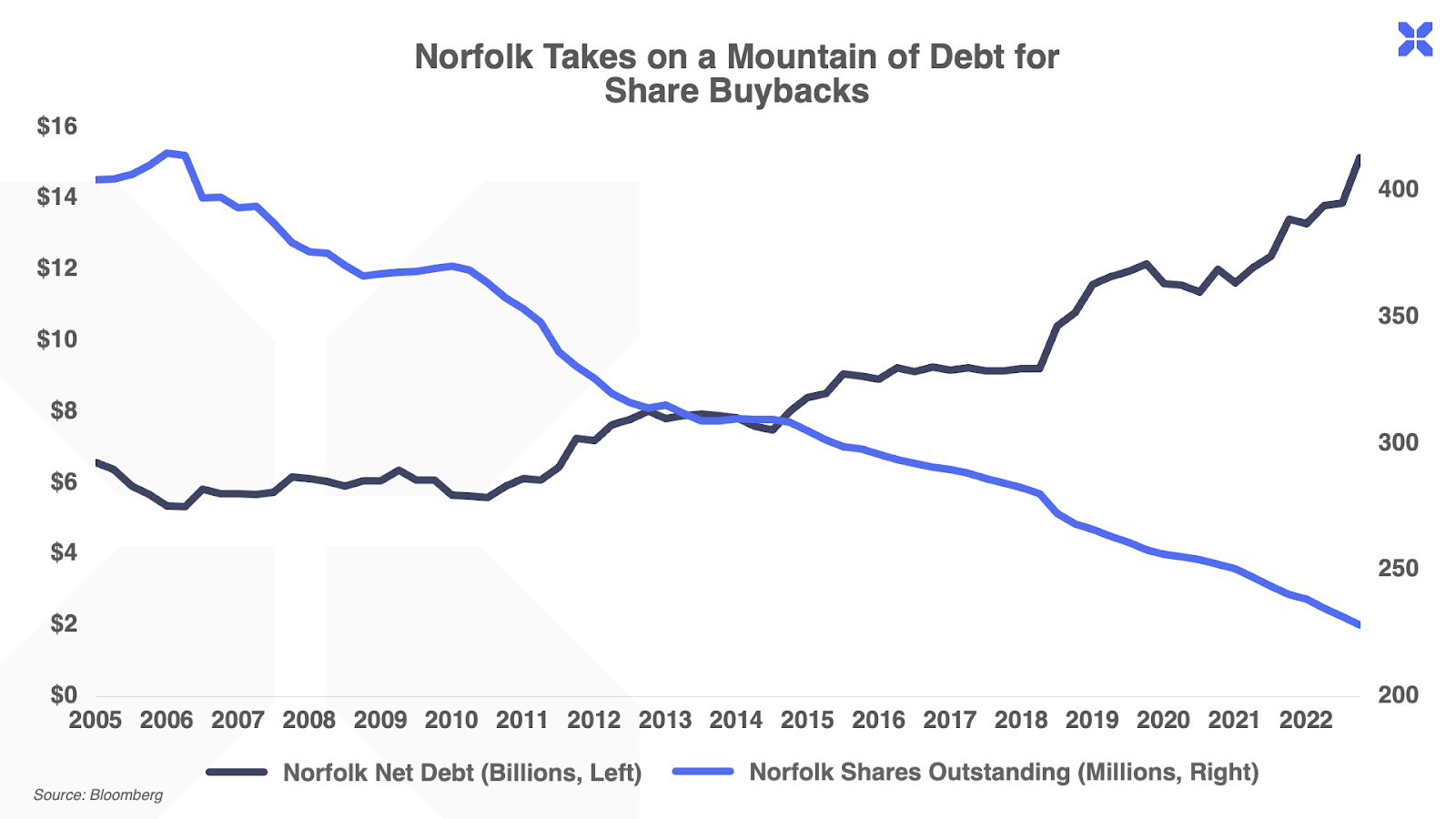
America’s Crumbling Rail Infrastructure Primed for More Disaster
| If you’re new here: Welcome! You’re reading “Something You Don’t Know,” Porter’s complimentary e-letter. It reveals a hidden market story, or dissects a largely misunderstood element of investing, every other Friday, at no charge. You can see our archive of earlier issues at this link. If you’d like to access Porter’s long-form analysis, you can sign up for The Big Secret on Wall Street here. |
Hunter Harrison was a teenage delinquent.
Growing up in Memphis, Tennessee, he frequently clashed with the law – and with his stern police officer father. In 1968, during his junior year, he failed every single class except P.E.
After barely graduating high school, he landed a job lubricating axles on the Frisco Railway, for $2 an hour.
But it was a start, and Harrison got his act together to become arguably the greatest railroad CEO of all time.
Over the course of Harrison’s extraordinary career, he led four back-to-back turnarounds as the CEO of railway companies Illinois Central, Canadian National Railway (CNI), Canadian Pacific Railway (CP) and CSX (CSX).
In each case, he started with a struggling business barely breaking even, and unleashed a cash flow windfall that generated a total of around $50 billion in wealth for shareholders.
And Harrison did it all without any formal training, or college degree. He had something far more important: common sense, and a vision of how to apply it.
Harrison gleefully upended the traditions of the stagnant railway industry, which had hardly evolved since the Civil War era. Known as “Seagull,” he would “fly in and sh*t all over everything, and leave”. He also literally wrote the book on running a precision railroad. (A used copy is available on Amazon for $400.)
His mantra was simple yet profound: “If an asset isn’t used, it’s a liability.”
Until Harrison left his mark, the railroad industry wasted lots of things: time, money, energy, assets.
He pushed employees to perform faster inspection and maintenance work, so that rail cars spent more time moving – and generating revenue – instead of sitting idle in the railyard. He increased train lengths across the board, realizing that it took the same number of employees to run a train with 50 cars, as one with 100. He optimized routes to ensure trains spent less time idling in between revenue-generating transport runs.
Most importantly, Harrison created systems to monitor and track the key data along the way… so that railroad execs could see exactly where and how their resources were being used.
Harrison’s playbook became known as Precision Scheduled Railroading, or PSR. It changed the essence of one of America’s foundational industries.
But the story of PSR doesn’t end well. As Warren Buffett once explained, “What the wise man does in the beginning, the fool does in the end.”
What happened is that over the past decade, almost every American railroad – a critical industry that ships 40% of long-distance freight across America – adopted PSR standards.
And then things began to go wrong.
After cutting out all the fat, PSR-style, the C-suite of America’s railways began slicing into the muscle and bone of their operations. The top seven Class I rail companies in America cut their staff by a third over the last decade. Profits soared.
But safety fell by the wayside.
Following a 32-car train derailment in Hyndman, Pennsylvania, that released liquefied petroleum gas and molten sulfur in an intense blaze that burned uncontrolled for over 12 hours, Harrison appeared in a 2017 hearing before the Surface Transportation Board. He was struggling with advanced emphysema and would be dead two months later.
Perhaps that’s why he felt free to admit that his brainchild of PSR was a mixed blessing at best…
“I got blood all over my hands… From injuries in this industry that should have been avoidable. And I think these issues of safety never fall to the wayside with us. And they always will be.”
From Common Sense to Profiteering
Norfolk Southern (NYSE: NSC) is one railroad company that took Harrison’s cost-cutting advice too far… with disastrous results.
To start with, over the past ten years NSC cut its employee count by 40%:

Then they moved on to “time-saving” measures… which meant reducing safety inspections.
Before PSR, Norfolk workers would spend roughly three minutes inspecting rail cars in between runs. Five years ago, Norfolk management imposed a time limit of 2.5 minutes per car. Seeing the positive results to the bottom line, management further cut inspection limits to 1.8 minutes… and then again, to 1.5 minutes.
Today, Norfolk workers spend just 1.4 minutes – that’s 84 seconds – performing safety inspections on rail cars that are 100 feet or more in length.
In 2021, alternative media outlet Vice News reported widespread frustration among Norfolk workers, who no longer had time to complete thorough inspections under the draconian time limits. Instead, workers said that their railyard bosses – under pressure from the the suits upstairs to keep the trains moving – encouraged widespread falsification of inspection reports:
“Our bosses now, they basically told us, just lie… lie on that inspection sheet… write bogus times, to satisfy ’em.”
According to Vice, another Norfolk employee observed a train enter his yard with freight cars that had traveled 90,000 miles without inspection. The U.S. Department of Transportation regulations state that rail cars should travel no further than 3,500 miles without an inspection. The worker estimated that the 60-car train had “major defects” on 13 of the cars.
The same article reported on an interview with a 40-year rail veteran, who said he’d “never seen anything like it”. The worker explained…
“They’re just cutting everywhere, on both ends of everything. Railroads haul the most dangerous gasses in the world. I do think it’s a matter of time. There’s going to be a freight car that hasn’t been inspected in 90,000 miles that comes off the track, as it goes off the track and slams into other cars, into a tank car, and either explodes or leaks poisonous gas out. It’s going to take something like that, and a lot of deaths, and then all of a sudden everybody’s going to care.”
That prediction, sadly, proved remarkably prescient.
“Precision Railroading” Leads to Disaster
On Friday, February 3 – earlier this month – a Norfolk Southern train derailed near the town of East Palestine, Ohio. The small town of 5,000 people is located about 50 miles northwest of Pittsburgh.

Dozens of railcars were overturned, including five that were hauling vinyl chloride – an industrial chemical used to make PVC plumbing pipe, among other applications. By midday Saturday, a fire began to smolder, making a deadly explosion a very real possibility.
Vinyl chloride is highly combustible, and vaporizes at just 8 degrees Fahrenheit. To transport it via rail, the gas is cooled and compressed into a liquefied form.
Norfolk Southern and local state officials feared that the vinyl chloride-carrying tankers might blow up. So they chose to drain the tankers, and ignite the chemicals in what they called a “controlled burn.”
On Sunday, Norfolk told East Palestine residents within a one-mile radius of the overturned rail cars to leave their homes. Officials also warned residents that the “controlled burn would send phosgene and hydrogen chloride into the air.”
A quick chemistry lesson: Phosgene is a deadly toxin that made up the active ingredient in mustard gas – a chemical weapon used in World War I. Hydrogen chloride can cause chemical burns and respiratory failure. When it combines with water, it forms hydrochloric acid, a powerful industrial chemical used to strip rust from steel. Hydrogen chloride also combines with moisture in the atmosphere and returns to Earth in the form of acid rain.
The derailment also released several other toxic chemicals, butyl acrylate, ethylhexyl acrylate and ethylene glycol monobutyl, all of which are used in plastic and paint manufacturing.
On February 6, Norfolk ignited the chemical spill, unleashing a massive black plume over East Palestine that was visible from miles away (and reportedly even showed up on satellite images from space):

One look at the sheer size of this mushroom cloud of toxic chemicals suggests that the one-mile evacuation radius was probably optimistic. The New Republic interviewed residents both inside and outside the one-mile radius who have suffered from migraines, rashes, and burning sensations, among other symptoms.
Norfolk and the Environmental Protection Agency announced the “all-clear” for residents to return to their homes on February 8. This, too, may have proved an optimistic timeline.
Nearby resident Amanda Greathouse evacuated within an hour of the accident. On February 10, she briefly returned home to pick up some items left behind from the initial evacuation. She could smell a pervasive odor even through her N-95 mask, and developed a sore throat and burning sensation in her eyes. Her husband and both sisters suffered migraines from the brief exposure.
In addition to airborne contamination, a portion of the chemical spill leaked into surrounding waterways, including the Ohio River – a key source of drinking water for over 5 million people. The director of Ohio’s Department of Natural Resources said that around 3,500 fish died in local waterways after the accident.
While the investigation remains ongoing, it’s clear that this Norfolk train derailment will go down as one of America’s worst ecological disasters. Still, mainstream media reporting on the incident remains scant.
Two days after the accident, Transportation Secretary Pete Buttigieg appeared on NBC’s Sunday talk show “Meet the Press.” The hour-long conversation covered numerous topics, ranging from Chinese spy balloons to the latest unemployment report… but not a single mention of the ongoing environmental disaster in Ohio. A full 10 days elapsed before Buttigieg issued a public statement on the East Palestine situation.
Given the dismal coverage from mainstream press and policymakers, we likely won’t know the full scope of the fallout for many weeks, if ever.
But what we do know is that this wasn’t a one-off, freak accident. It’s part of a systemic issue of drastic cost cutting and underinvestment, in the ravenous pursuit of profit at all costs.
Norfolk Skimps on Infrastructure to Fund a Buyback Bonanza
Not only has Norfolk slashed expenses by cutting employee headcount, but it has also severely underinvested in capital equipment, including its locomotive and rail car fleet.
Before Norfolk instituted PSR in 2019, during the five year period from 2013 – 2017, the company added 260 new locomotives and 4,202 new freight cars to its fleet. But during the “PSR era,” the most recent five-year period from 2018 – 2022, Norfolk added just 62 new locomotives, a nearly 80% decline versus the previous five-year period. Meanwhile, the number of rail cars built fell by 90% to just 436 new units.

The one place where Norfolk has spent lavishly has been in share buybacks. Not only has the company outspent its free cash flow on repurchasing shares, but it’s also doubled its net debt to $15 billion in order to shrink its share count by roughly 30% over the last decade:

Shareholders loved the strategy, as Norfolk’s stock price increased 5-fold from $60 in 2012 to a high of $300 by early 2022.
Trimming staff back to bare-bones levels, and funneling all available free cash flow into buybacks instead of investing in its business, has come at a cost. The rate of Norfolk train accidents has increased by 25% in the last three years alone:

The question is: will Norfolk be held accountable for its reckless pursuit of profits over safety? Or will the company get away with business as usual: privatized profits and socialized losses, paid for by vulnerable communities like East Palestine, and countless others spanning America’s 140,000 miles of railways?
Absent change, we should expect more of the same. And that’s a scary thought..
The Next Risk: A Hiroshima-Sized Mushroom Cloud
In recent years, environmental activists have pressured policymakers to impose restrictions on natural gas pipeline construction. But America’s consumption of natural gas continues to rise. As a result, in 2020 the U.S. Department of Transportation authorized U.S. rail carriers to transport natural gas, in the form of liquefied natural gas (LNG).
These LNG tankers hold vast amounts of energy that could be unleashed in the all-too-likely event of a train derailment.
How much energy, exactly? Well, it would only take 22 tanks filled with the standard shipment size of 30,000 gallons of LNG to unleash more energy than the nuclear bomb dropped on Hiroshima at the end of World War II.
Today, the Department of Transportation allows 100 or more LNG tanker cars to traverse America’s railroads, with no additional safety regulations.
Hopefully, America never faces this scenario. But the C-suites running America’s railroads will need a serious change in priorities… along with some encouragement from policymakers. And the East Palestine disaster may provide the necessary wakeup call.
On February 15, Ohio Senator J.D. Vance and Florida Senator Marco Rubio penned a letter to the Transportation Department requesting information about how the aggressive cost-cutting measures of PSR have contributed to rising rates of rail accidents in recent years:
“While officials at the department’s Federal Railroad Administration have said that data are inconclusive when it comes to the effects of PSR on rail safety, derailments have reportedly increased in recent years, as has the rate of total accidents or safety-related incidents per track mile. The trade-off for Class I rail companies, of course, has been reduced labor costs, having shed nearly one-third of their workforce.”
Pennsylvania Governor Josh Shapiro went even further. On February 22, Shapiro filed a referral to the Department of Justice to pursue criminal charges against Norfolk Southern. Shapiro didn’t hold back in his criticism against the railroad in his letter to the DOJ, noting:
“The combination of Norfolk Southern’s corporate greed, incompetence and lack of care for our residents is absolutely unacceptable.”
Railroads, the Next Victim of the Coming Corporate Credit Bust?
If railroad operators like Norfolk come under much-needed regulatory scrutiny, shareholders should take note: Because share prices will suffer… and worse.
To avoid the next East Palestine (or worse), railroads may need to rehire thousands of workers laid off over the past decade, and allocate more time in their schedules for things like safety inspections. This means the inflated profits railroads enjoyed over the past decade could go up in smoke.
Plus, instead of funneling all available free cash flow towards share buybacks, railroads will need to spend more on much-needed infrastructure upgrades.
Since 2010, the biggest American railroads have spent $196 billion on share repurchases and dividends, or roughly 40% more than the $138 billion spent on capital expenditures for infrastructure over the same period. Should these trends reverse, railroad shares will face a much steeper hill to climb.
And for companies that relied heavily on debt to fund buybacks, the outlook is even more sobering. Today, Norfolk’s bloated balance sheet contains over $15 billion in debt, supported by only $2 billion in annual free cash flow.
Norfolk has put itself in a vulnerable financial position that will only be further pressured by higher operating costs. (Not to mention, it is now on the hook for cleaning up an ecological disaster, and faces potential criminal liability.) Throw in the threat of a potential recession, which is notoriously painful for the highly cyclical rail industry, and the situation could go from dire to impossible.
As a result, Norfolk could be among the countless casualties when today’s credit cycle turns.
That’s bad news for today’s shareholders. But it could create an incredible opportunity for bond investors who buy at the right price.
Remember, when companies enter financial distress, share prices and dividend payments can go to zero at any time… but bondholders always get paid first – by law. As the senior owners of claims on a company’s assets, bondholders are the ones left standing to pick up the pieces.
So when distressed corporate bond prices collapse to pennies on the dollar, savvy investors will be ready to pounce… and pick up the remaining ownership claims on critical pieces of America’s infrastructure. Railroads are just one example of industries that we expect to enter severe distress starting this year.
We’ve spent the last several months building out a team of distressed debt veterans, led by a Wall Street legend known as the “dean of high yield.” We’re preparing for a once-in-a-lifetime meltdown in the corporate bond market, where many will lose everything… and a small few will make fortunes. This event will become known as the greatest legal wealth transfer in history.
To learn more about how we’re planning to help investors get on the right side of this generational wealth transfer, click here.
Porter & Co.
Stevenson, MD
P.S. If you’d like to learn more about the Porter & Co. team – all of whom are real humans, and many of whom have Twitter accounts – you can get acquainted with us here.